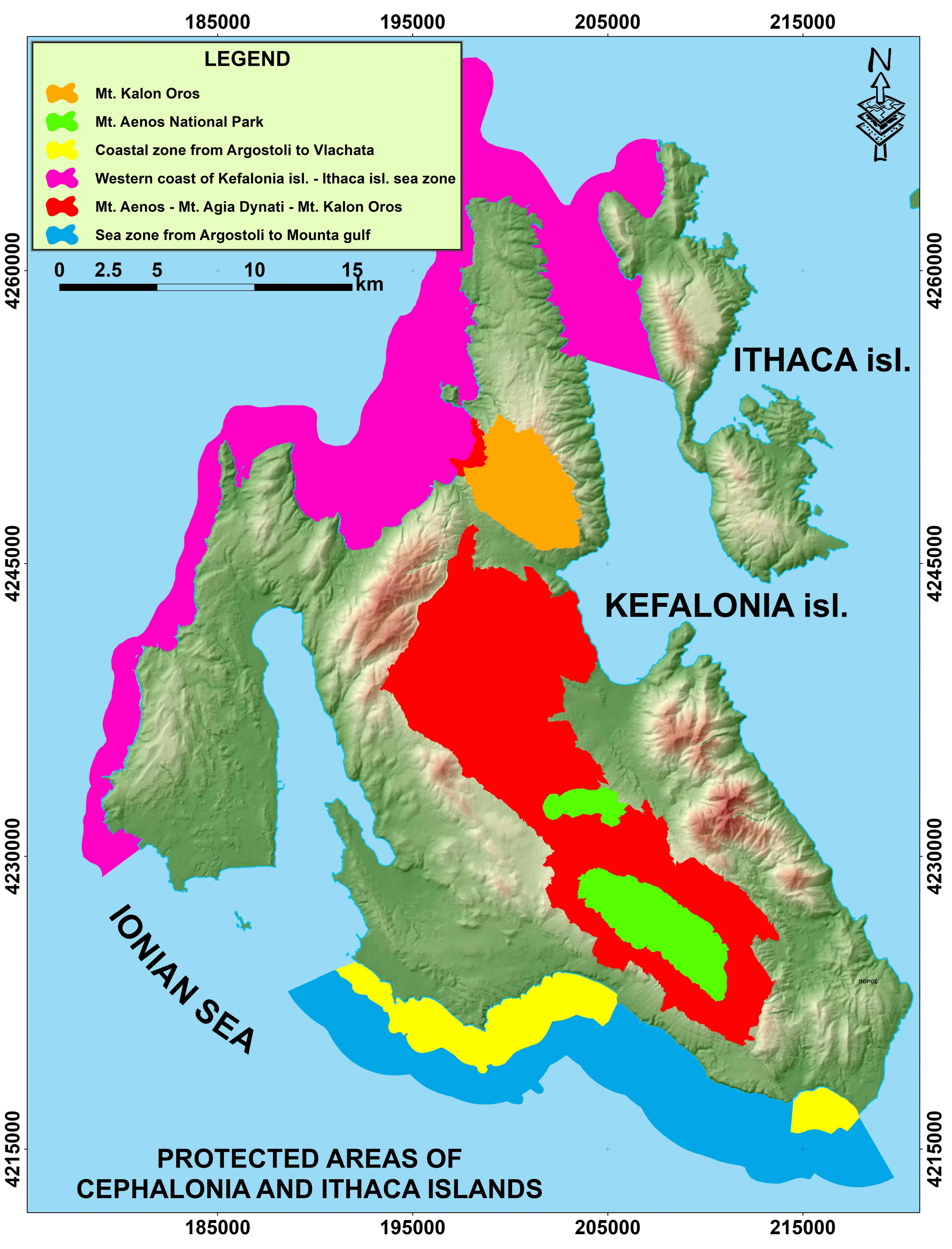Aenos National Park is the smallest National Park in Greece with a total core area of 28,620 ha. It was founded in 1962 by the Royal Decree 766 with the main purpose to protect the forest of the Kefalonian Fir (Abies cephalonica Loudon), which is an endemic species to Greece and among all the Ionian islands, it is found exclusively on Mount Aenos (Fig. 1). Aenos represents the locus classicus of Kefalonian Fir, which was described as a new species by the English Botanist Loudon JW in 1838 (Fig. 2). Another purpose for its establishment as a National Park was the protection of the rich flora and fauna and peculiar biodiversity. The core of the National Park consists of two neighboring areas, although independent from each other; the main area of 23,160 ha around the top called Megas Soros (altitude 1628 m) and the second area of 5460 ha called Roudi or Gioupari (altitude1125 m). Megas Soros together with Roudi (or Gioupari), constitute Aenos mountain range.
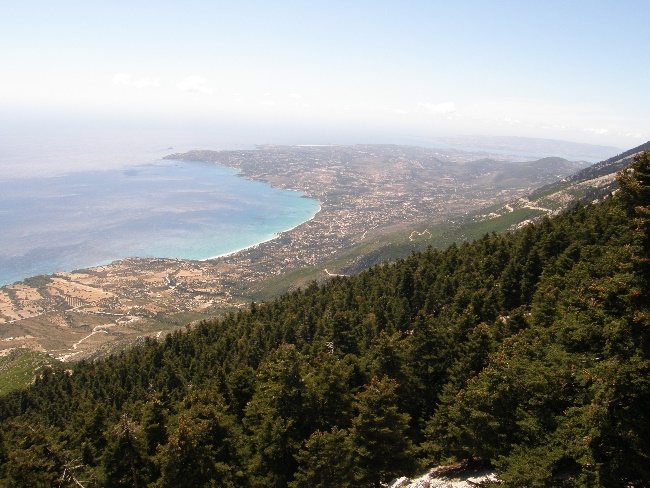
|

|
In recognition of its importance, Aenos National Park has been designated at an international level as a European Biogenetic Reserve. It is also a Site of Community Importance (SCI) and a Special Area of Conservation (SAC) of the European Natura 2000 Network with the code (GR2220002); it is comprised in a Special Protection Area for avifauna (SPA) (protected area GR2220006). Simultaneously to its proclamation to National Park, it was designated as a Wildlife Refuge. The protected areas of Kefalonia and Ithaca which make part of the European Natura 2000 network are mentioned in the Table below:
|
α/α |
Natura Code |
Location |
|
1 |
GR2220001 - SCI / SAC |
Kalon Oros Kefalonia |
|
2 |
GR2220002 – SCI / SAC & SPA |
Aenos National Park |
|
3 |
GR2220004 - SCI / SAC |
Paraktia Thalassia Zoni, apo Argostoli eos Vlahata & Ormos Mounta |
|
4 |
GR2220005 - SCI / SAC |
Ditikes Aktes Kefalonias - Steno Kefalonias Ithakis - Voria Ithaki (Acrotirio Gerogobos – Drakou Pidima - Kedri – Agios Ioannis) |
|
5 |
GR2220006 - SPA |
Kefalonia: Aenos, Agia Dinati & Kalon Oros |
|
6 |
GR2220007 - SCI |
Thalassia zoni apo Vlahata eos Ormo Mountas |
The map (Fig. 3) illustrates the Protected Areas of Kefalonia and Ithaca, which are also the areas of responsibility of N.E.C.C.A. Organization in Kefalonia-Ithaca islands.
The administration and management of the protected areas of the National Park fall under the responsibility of N.E.C.C.A. and the Forest Directorate of Kefalonia. N.E.C.C.A. the sole successor of the National Center for Environment and Sustainable Development (NCESD) and the 36 Management Bodies of PAs. The process of succession and renaming of the NCESD to “Natural Environment and Climate Change Agency” (N.E.C.C.A) was determined by legal provisions in laws 4685/2020, 4722/2020 and 4819/2021.
During the first phase of its operation, Management Body of Mt. Aenos National Park implemented the Action entitled “Management and Operation of Aenos National Park” funded by the Operational Program “ENVIRONMENT 2000-2006” and completed the Action entitled “Protection and Conservation of Biodiversity on Aenos National Park " which was included in the Operational Program "ENVIRONMENT AND SUSTAINABLE DEVELOPMENT 2007-2013, with extension to the end of 2015" (Priority Axis 9 - "Protection of the Natural Environment and Biodiversity") of the NSRF, co-financed 80% by the European Union and 20% from national resources. For the 2014-2020 period N.E.C.C.A. will additionally implement the Action entitled: "Recording and presentation of Geosites & Geotrails of Kefalonia - Ithaca Geopark with the aim of its inclusion in UNESCO Geoparks Network". The priorities set by N.E.C.C.A. for the current management period until the end of 2023, have as an ultimate goal apart from the designation of Kefalonia - Ithaca Geopark in UNESCO Global Geoparks Network and the development of innovative management actions for the protection of biodiversity in all the Protected Areas of Kefalonia - Ithaca.
To date, N.E.C.C.A. implements actions divided into five main axes:
I. Recording and monitoring of Protected Areas key biodiversity
Recording and monitoring biotic parameters by the N.E.C.C.A. personnel or in by assignment to external partners, in the context of the implementation of European programs by own means are the following:
1. Recording, monitoring and sustainable management of Flora species in Aenos National Park and also in the wider area of Kefalonia and Ithaca
About 400 species of plants are registered in Aenos National Park, 36 of which are endemic to Greece, 7 are endemic to the Ionian Islands and 2 grow exclusively in the National Park (Foitos & Damboldt 1985, Efthymiatou-Katsouni 1998, Efthymiatou-Katsouni 2012). Among the exclusive endemic species, Viola cephalonica Bornm holds a prominent position. It is the rarest plant of Kefalonia, since it is found only in the highest peaks of Mount Aenos, in stony soils and rock crevices (Fig. 5a). It is a narrow endemic species to Mount Aenos, which has been characterized as Critically Endangered according to IUCN criteria (2001), in the The Red Data Book of Rare and Threatened Plants of Greece (Foitos et al 2009).
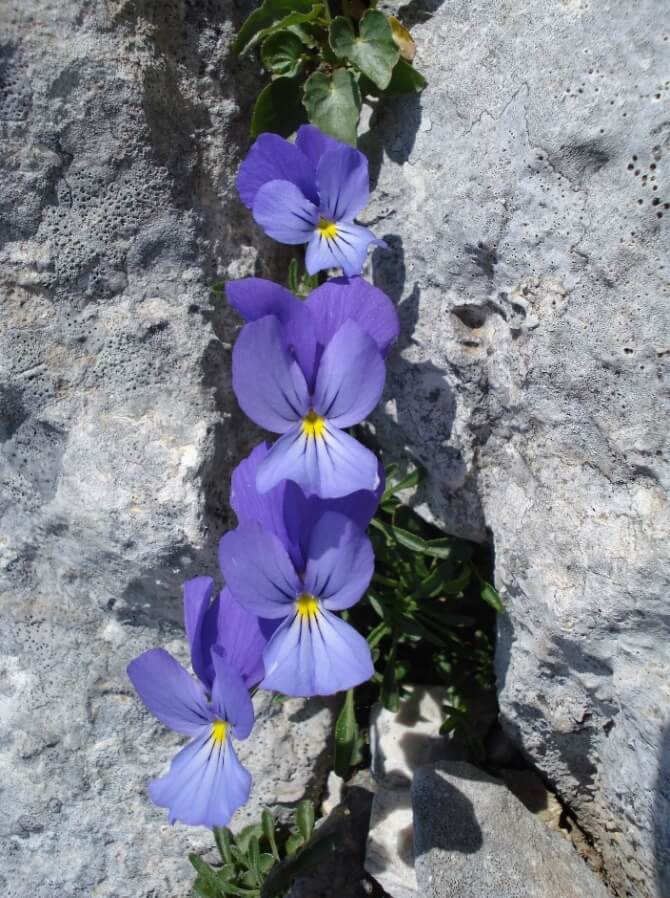
|
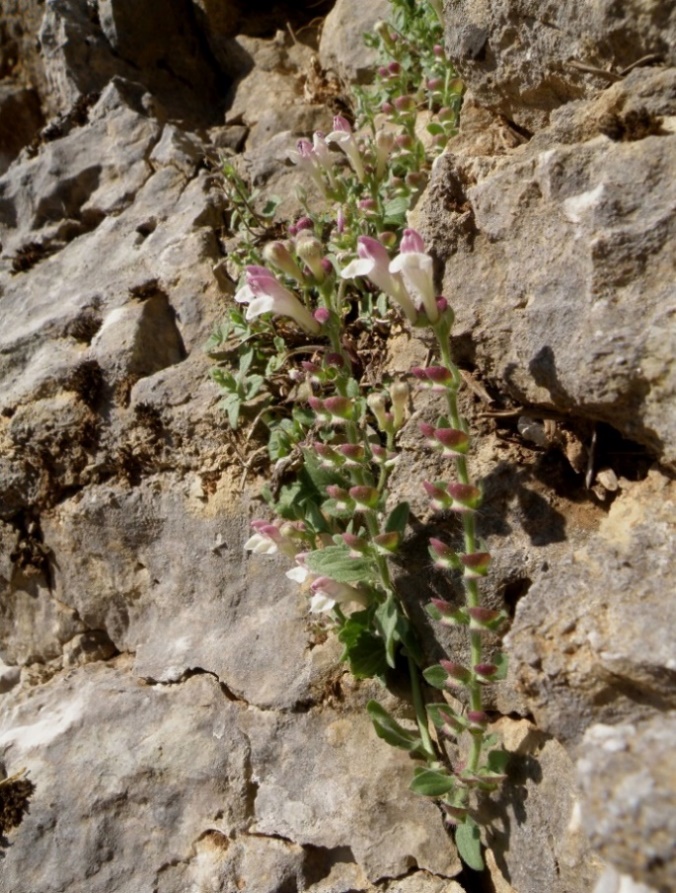
|
Another endemic species, registered exclusively in Aenos National Park, is Scutellaria rupestris subsp. cephalonica (Bornm.) Greuter & Burdet (Fig. 5b). It is found on Aenos higher altitudes, where grows Viola cephalonica. The latter has been designated as Endagered (EN) in the Red Data Book (Foitos et al 2009), mainly due to the restricted size of its population. Some other endangered, endemic species of the Ionian phytogeographical area, which have been detected on mount Aenos and are also included in the Red Data Book, are the following: Saponaria aenesia Heldr designated as endangered species (ΕΝ) (Fig. 6), Campanula garganica subsp. cephallenica (Feer) Hayek (Fig. 7), designated as Vulnerable (VU) and Ajuga orientalis subsp. aenesia (Heldr) (Foitos & Damboldt) (Fig. 8). On Mt Aenos also grow some Greek endemic or rare plants, such as Centaurea subciliaris Boiss & Heldr subsp. subciliaris, Cerastium illirycum Ard subsp. illirycum, Fritillaria mutabilis Kamari, Thymus holosericeus Čelak, etc.
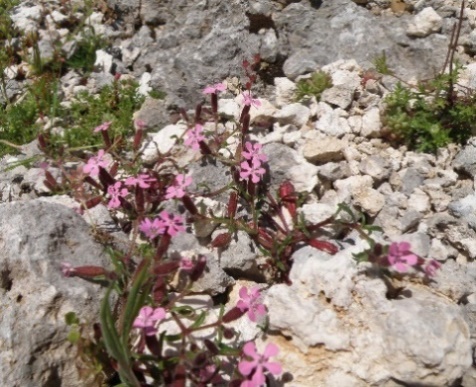
|
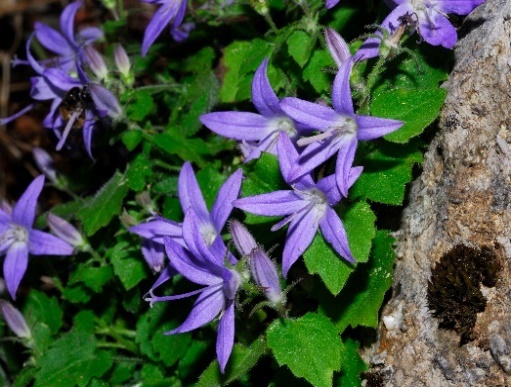
|

|
Management Body of Mt. Aenos National Park completed the study in the programming period 2007-2013 (2015) about the recording and monitoring of 17 rare and endemic flora species of Aenos National Park.
2. Recording, monitoring and sustainable management of Fauna species living in Aenos National Park, and the wider area of Kefalonia and Ithaca
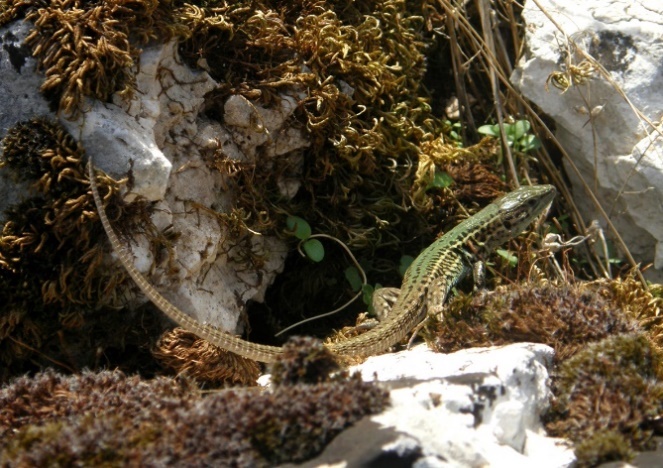
|
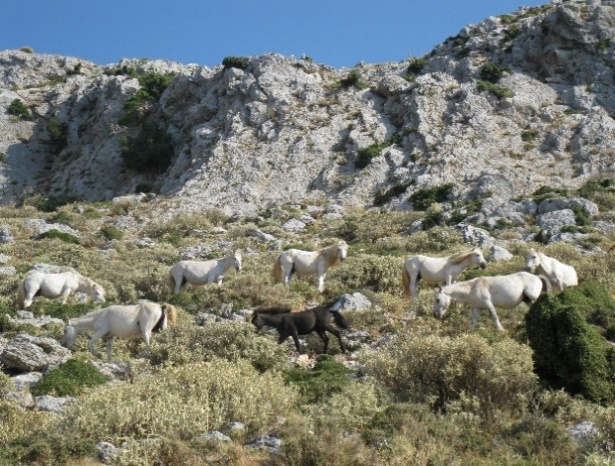
|
Vertebrates whose presence can be perceived in the area of Aenos National Park and the wider area of Kefalonia are the reptiles Podarcis tauricus Pallas subsp. ionicus (Fig. 9), Algyroides moreoticus Bibron & Bory, Vipera ammodytes Linnaeus, the mammals Erinaceus roumanicus Barrett-Hamilton (white-breasted hedgehog), Talpa stankovici Martino V & Martino E (Balkan mole), Myoxus glis Linnaeus (edible dormouse), Lepus europaeus Pallas (European hare), many bat species, etc. In the area of the Holy Monastery Zoodochos Pigi (meaning the life giving source) a group of 35 horses (Equus caballus Linnaeus) is recorded which live in a semi-wild state (Fig. 10).
During the programming period 2007-2013 (2015) Management Body of Mt. Aenos National Park completed the recording and monitoring of rare and endemic fauna species of Aenos National Park in Kefalonia, especially reptiles, amphibians, micro-mammals, bats and Aenos semi-wild horses.
3. Recording, monitoring and sustainable management of Avifauna species in Aenos National Park
More than 100 species of avifauna have been recorded in the area of the National Park: Circaetus gallicus Gmelin (short-toed snake eagle), Falco biarmicus Temminck (lanner falcon), Pernis apivorus Linnaeus (honey buzzard), Accipiter gentilis Linnaeus (northern goshawk), Buteo buteo Linnaeus (common buzzard), Alectoris graeca Meisner (rock partridge), Emberiza caesia Cretzschmar (Cretzschmar's bunting), Lanius senator Linnaeus (woodchat shrike) etc. The study conducted by Management Body of Mt. Aenos National Park in the programming period 2007-2013 (2015) concerned the recording and monitoring of rare and endemic avifauna species thriving in Aenos National Park, within the Special Protection Area, and the two important wetlands of the island (wetland Livadi and Koutavos lagoon).
4. Recording, monitoring and sustainable management of Habitat Types of Aenos National Park
The study was completed by Management Body of Mt. Aenos National Park in the programming period 2007-2013 (2015) and concerned the recording, monitoring and mapping of Habitat Types in the core and the peripheral zone of Aenos National Park.
5. Recording and monitoring of macrofungal species (mushrooms) in Aenos National Park
The study conducted by Management Body of Mt. Aenos National Parkin the programming period 2007-2013 (2015) and was related to the recording and monitoring of mushrooms species (Fig. 11a, 11b) thriving in the core and the peripheral zone of the National Park.

|
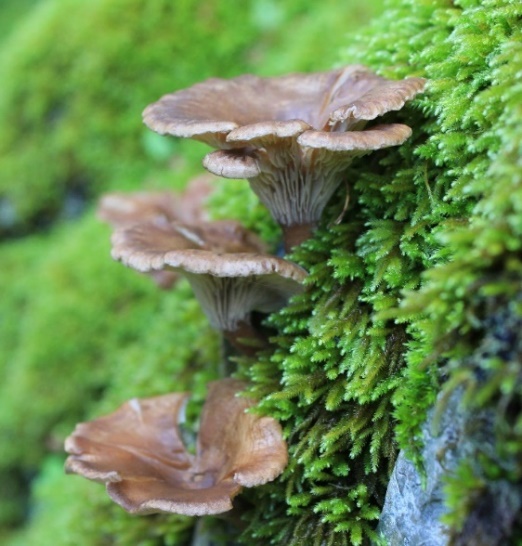
|
II. Surveillance-Guarding and Management of the Protected Area:
N.E.C.C.A. is engaged with the important role of the Supervision/Guarding of Aenos National Park and the other protected areas of Natura 2000 Network of Kefalonia and Ithaca. The effective Surveillance/Guarding of the Protected Area is ensured by the preparation and implementation of a Guarding Plan, which aims at the daily presence of N.E.C.C.A. personnel within the Protected Areas. N.E.C.C.A. disposes of two 4x4 vehicles equipped with binoculars, photographic equipment, video camera, portable GPS, toolboxes, chainsaws, digging tools, marking tapes, security equipment, etc. Except of recording illegal activities within the Protected Areas, the Supervision/Guard personnel of N.E.C.C.A. takes care of the maintenance of the forest recreation infrastructure, the removal of fallen trees and rocks from the forest road network (Fig. 12a & 12b) and the provision of assistance to visitors of Aenos National Park and the other protected areas of Kefalonia – Ithaca. N.E.C.C.A. actively cooperates and coordinates with competent authorities (Forest Service, Fire Service) responsible for the Supervision/Guarding. Ensuring compliance with the operating regulations for the Protected Areas contributes significantly to their effective protection.
 |
 |
Figures 12a & 12b. Removal of fallen trees from the forest road network
The Supervision/Guarding is carried out either by the elaboration or the proclamation of important studies and research for the National Park, such as:
(i) Study for the accurate definition of the Core boundaries within the Protected Area
(ii) Study for the configuration of the exterior space of Aenos Environmental Center
(iii) Study for the Management Plan of the Protected Area
(iv) Study for the grazing management in the peripheral zone of Aenos National Park
ΙΙΙ. N.E.C.C.A. Communication strategy, Information/Awareness actions:

|

|
In order to implement the planned actions for the protection, promotion and management of the Protected Areas of Kefalonia-Ithaca in a successful way, it is necessary that N.E.C.C.A. clarifies its role and be accepted by the local community. Therefore, an integrated communication strategy has been established and implemented throughout the program, which aims to highlight the central role of N.E.C.C.A. in the management and protection of Aenos National Park and the rest of the protected areas and to strengthen the participatory process of organized groups, and ordinary citizens.

|

|
To achieve this important goal, the specific Axis of Actions includes the information and awareness of residents, visitors and organized groups. For this purpose, special presentations are organized at the Environmental Education Center (N.E.C.C.A. headquarters) in Koutavos, Argostoli, as well as at Aenos Environmental Center, and along the five forest trails of Aenos National Park (Fig. 13a & 13b) for which specific information and thematic signs have been prepared by N.E.C.C.A. (Fig. 13a). The issues raised concern the particular abiotic and biotic characteristics, the value of the ecosystems of Aenos National Park, and the pressures and threats they receive. The purpose of these activities is to awaken citizens towards the need for the protection and respect of the Protected Areas, and the undeniable benefits that derive. Such activities include the environmental education in primary (Fig. 14) and secondary (Fig. 15) school students, the use of modern electronic media (website, digital museum, virtual tour, etc.), the production and distribution of various printed materials, such as posters, leaflets, books, cards, etc., the information material in electronic form, the holding of Conferences on environmental topics (Presentation of the Institution Actions - Fig. 16, Orchids - Fig. 17, Mushrooms, etc.) and Seminars (Aromatic Medicinal and Edible Plants, Ecotourism - Fig. 18, Fire Protection - Fig. 19, Flora, Fauna, etc.), the targeting of specific groups of citizens, the dissemination of the spirit of volunteerism through the multi-year operation of N.E.C.C.A. as a Host Agency for foreign volunteers in the framework of the European Voluntary Service (EVS) program, etc.

|

|

|

|
IV. Administrative support for the implementation of actions under the operational program:
Consistent and accurate administrative support of the program is an important component in achieving the goals set by the Management Authority about the program implemented by N.E.C.C.A. concerning both its physical and financial object. The compliance of the time schedules, writing, receiving by the competent departments and sending to the competent authorities the deliverables of the individual actions, as well as the anticipation and confrontation of factors that may lead to delays are the subject of the fourth axis of Actions.
V. Development of innovative actions:
- Gene Bank Operation & Laboratory for Flora Species Regeneration (Fig. 20a, 20b)
- Investigation on the historical evolution of Mount Aenos vegetation
- Creating an infrastructure for monitoring using G.I.S. log file data
- Designation of Kefalonia-Ithaca Geopark in UNESCO Global Geoparks Network

|

|
VI. Participation in national and international organizations Networks
N.E.C.C.A. participates in Greek and international forums aiming at the protection of Kefalonia & Ithaca biodiversity in combination with the sustainable development of the protected areas. In order to achieve this goal, attention will be given to people who live and work in the wider area of Kefalonia and Ithaca protected sites, ie people working on the primary sector, tourism, etc. N.E.C.C.A. seeks cooperation with Greek Agencies, as well as with other European parks. Priority areas for cooperation include know-how exchange, ways to develop ecotourism, environmental protection, mitigation of climate change effects and sustainable development of the protected areas.
VII. Designation of Kefalonia-Ithaca Geopark in UNESCO Global Geoparks Network
Until recently, environmental protection has been correlated to the protection of biodiversity. However, in recent years a new dimension in the protection of the environment has been added, the protection of Geodiversity. The protection of the abiotic environment and more specifically of the geoenvironment is considered equally important with the protection of biodiversity. Geological formations and processes determine the physiognomy of an area, and therefore its biodiversity; for this reason the protection of geodiversity significantly contributes to the protection of biodiversity. In many cases, geodiversity determines the anthropogenic environment and greatly influences moral identity and traditions of local communities.
The connection of geodiversity to biology, landscape and anthropogenic environment in combination with the sustainable development, may take place within a Geopark, in which the geological and natural inheritage of an area is highlighted, along with the promotion of archaeological and cultural monuments, such as the Holy Monastery of Agios Gerasimos in Omala or the obelisk in the port of Argostoli (Fig. 21a, 21b). In a Geopark the protection of the abiotic and biotic environment "goes hand in hand" with the gentle development of the local communities through growth of a different alternative tourism, the "geotourism" interested in geological monuments and high quality local products.
A Geopark is characterised by its geosites, a set of geological monuments of an area that need promotion and protection, and by geological trails connecting geotopes one with another as well as with other natural and cultural monuments of the area. Good signage and information material enable visitors to get acquainted with the geology, the natural environment and the culture of the area.
Once a Geopark becomes operational, it can join the European and Global Network of Geoparks, which have been under the auspices of UNESCO since 2015. A designated Geopark becomes a member of the Network of UNESCO Global Geoparks and it is under the protection status of UNESCO. The UNESCO Global Geoparks network aims to promote areas of international geological value and interest, which will be the basis for the sustainable development of local communities. The area of a Geopark will be able to use UNESCO logo.

|

|
In order to be designated in the Network of UNESCO Global Geoparks, a Geopark should first be organized to function already as a Geopark. This means that geotopes and geotrails should have already been defined, the relevant infrastructure should have been created and the local community and local actors should have embraced it. In order to create a Geopark is needed initial funding, so that Geologists with relevant experience can determine and highlight geotopes and geopaths and provide scientific information to support Geopark importance and need for protection. Biologists need to record habitats biodiversity especially in areas of special biological interest that need promotion and protection.
The islands of Kefalonia and Ithaca, apart from their rich archaeological and cultural history and biodiversity richness which led to the proclamation of mount Aenos as a National Park, are also important for geology, representing an active geological laboratory, which is located in the most active tectonic region of Europe. The geological formations, the large number of faults several of which are active, and consequently the great seismicity, caves and karst formations, Aenos and the remarkable marine environment create a geological "mosaic" pattern which renders the islands suitable with all the necessary specifications to become a Geopark, within which dozens of geosites and several geotrails could be defined. It would be appropriate to include in the Geopark, except the islands of Kefalonia and Ithaca, the inner Ionian Archipelago with its steep coastlines, which clearly depict the geology of the area and the coastal caves. In this way a unique Geopark in the European Area will be created which will include an important marine area, with a defined marine geo-route to connect the two islands or more precisely connect the geosites and the geo-routes of the two islands. The aim of the marine georoute is to attract a high level of tourism using pleasure boats to reach coastal geosites from the sea.
Then appropriate infrastructure should be created and local communities should be informed and sensitized to support the aspiring Geopark. Afterwards it would be possible to submit the relevant dossier for Geopark designation in the European and International Network of UNESCO Geoparks.
The Management Unit of Zakynthos, Ainos National Parks and Protected areas of Ionian islands with the appropriate staff, structures and experience will definitely facilitate the organization and operation of the Geopark. Besides, there is already an example of a Management Unit of Helmos-Vouraikos National Park and Protected Areas of Northern Peloponnese that operates as the manager of Helmos-Vouraikos Geopark (UNESCO Global Geopark).

|

|
Besides, the already exploited and well organized caves Melissani and Drogarati (Fig. 22a & 22b) represent the initial core and the model for the selection, promotion and protection of other geotopes of the Geopark. The aim of N.E.C.C.A. is to make Kefalonia-Ithaca Geopark function as an UNESCO Global Geopark at the European Geoparks Conference in 2019, to gain experience before its evaluation by the UNESCO committee and its designation in UNESCO Global Geopark Network.
The staff of the Management Unit of Zakynthos, Aenos National Parks and Protected areas of ionina Islands is always available and willing to provide any information about Kefalonia - Ithaca Geopark, Aenos National Park, Ionian islands protected areas in general, and about the tasks we perform. For this purpose, you can visit the website, www.necca.gov.gr, www.kefaloniageopark.gr or contact the staff (Tel./Fax: 26710-29258), E-mail: kefaloniageopark@necca.gov.gr You may also visit the headquarters of the Geopark at Koutavos Environmental Information Center, Argostoli, Kefalonia.
References
- Foitos D & Damboldt J (1985) Flora of the island of Kefallinia. Botanical Chronicles, 51, 2, 1-204 + 2 maps
- Efthymiatou-Katsouni N (1998) Tribute to Aenos National Park, Kefalonia. Museum of Natural History of Kefalonia-Ithaca Editions.
- Efthymiatou-Katsouni EN (2012) Human influences on the evolution of vegetation flora of Kefallinia from prehistoric times to present: A study for application in Environmental Education. Doctoral Thesis, University of Patras, p 417
- Foitos D, Konstantinidis Th & Kamari G (2009) Book of Red Data of Rare and Endangered Plants of Greece. Published in Hellenic Botanical Society Edition, Patra, Volume 1 (A-D), I-XXVI, 1-406 & Volume 2 (EZ), 1-414
- IUCN (2001) IUCN Red List Categories and Criteria: version 3.1. Gland & Cambridge: IUCN Species Survival Commission
